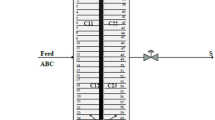Abstract
When genetic algorithms (GAs) are applied for PID parameter tuning, since the PID parameters are adjusted almost randomly, it is possible that the plant will be damaged due to abrupt changes in PID parameters. To solve this problem, a neural network will be used to model the plant and the genetic tuning procedure will be performed on the neural network instead of the plant. After determining the PID parameters in this off-line manner, these gains are then applied to the plant for on-line control. Moreover, considering that the neural network model may not be accurate enough, a method is also proposed for on-line fine-tuning of PID parameters. To show the validity of the proposed method, a seesaw system that has one input and two outputs will be used for experimental evaluation
Similar content being viewed by others
References
Ziegler, J. G. and Nichols, N. B.: Optimum setting for automatic controllers, Trans. ASME 64 (1942), 759–768.
Gawthrop, P. J. and Nomikos, P. E.: Automatic tuning of commercial PID controllers for singleloop and multiloop applications, IEEE Control Systems Magazine 10 (1990), 34–42.
Niederlinski, A.: A heuristic approach to the design of linear multivariable interacting control systems, Automatica 7 (1971), 691–701.
Akhyar, S. and Omatu, S.: Neuromorphic self-tuning PID controller, in: Proc. of IEEE Internat. Conf. on Neural Networks, 1992, pp. 552–557.
Matsumura, S., Omatu, S., and Higasa, H.: Improvement of speed control performance using PID type neurocontroller in an electric vehicle system, in: Proc. of IEEE Internat. Conf. on Neural Networks, 1994, pp. 2649–2654.
Tzafestas, S. and Papanikolopoulos, N. P.: Incremental fuzzy expert PID control, IEEE Trans. Indust. Electronics 37(5) (1990), 365–371.
Zhao, Z. Y., Tomizuka, M., and Isaka, S.: Fuzzy gain scheduling of PID controllers, IEEE Trans. System Man Cybernet. 23(5) (1993), 1392–1398.
Wang, P. and Kwok, D. P.: Optimal design of PID process controllers based on genetic algorithms, Control Engrg. Practice 2(4) (1994), 641–648.
Porter, B. and Jones, A. H.: Genetic tuning of digital PID controllers, Electronics Letters 28 (1992), 843–844.
Ota, T. and Omatu, S.: Tuning of the PID control gains by GA, in Proc. of IEEE Conf. on Emerging Technology and Factory Automation, 1996, pp. 272–274.
Holland, J. H.: Adaptation in Nature and Artificial Systems, University of Michigan Press, Ann Arbor, Michigan, 1975.
Goldberg, D. E.: Genetic Algorithms in Search, Optimization, andMachine Learning, Addison-Wesley, Reading, MA, 1989.
Gen, M. and Cheng, R.: Genetic Algorithms and Engineering Design, Wiley, New York, 1997.
Zurada, J. M.: Introduction to Artificial Neural Systems, West Publishing Company, St. Paul, MN, 1992.
Grefenstette, J. J.: Optimization of control parameters for genetic algorithms, IEEE Trans. System Man and Cybernet., 16(1) (1986), 122–128.
Funanashi, K. I.: On the approximate realization of continuous mappings by neural networks, Neural Networks 2 (1989), 183–192.
Hornik, K., Stinchcombe, M., and White, H.: Multilayer feedforward networks are universal approximators, Neural Networks 2 (1989), 359–366.
Poggio, T. and Girosi, F.: Networks for approximation and learnings, Proc. IEEE 78(9) (1990), 1481–1497.
Vogl, T. P., Mangis, J. K., Rigler, A. K., Zink, W. T., and Alkon, D. L.: Accelerating the convergence of the backpropagation method, Biological Cybernetics 59 (1988), 257–263.
Author information
Authors and Affiliations
Rights and permissions
About this article
Cite this article
Wu, CJ. Genetic Tuning of PID Controllers Using a Neural Network Model: A Seesaw Example. Journal of Intelligent and Robotic Systems 25, 43–59 (1999). https://doi.org/10.1023/A:1008077610571
Issue Date:
DOI: https://doi.org/10.1023/A:1008077610571




